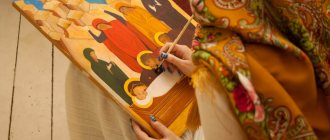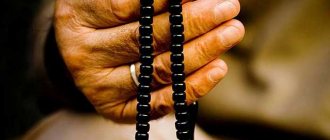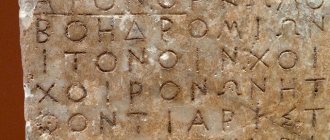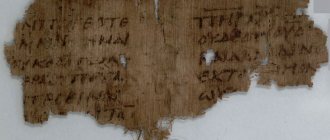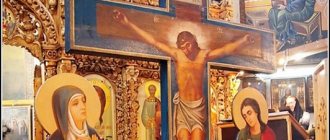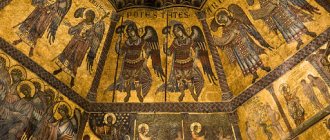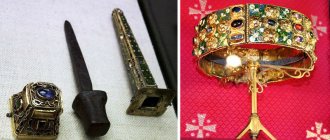Ancient Christian symbols that we know little about
In the first centuries of the terrible persecution of Christians, two unfamiliar fellow travelers met and sat down to rest. During the conversation, one, as if by accident, drew an arc in the sand with a branch.
When the second one completed the second arc, the image of a fish was created. This is the secret Christian way of distinguishing between enemies and friends. They immediately hugged each other and said, “Brother, I am a Christian too!”
Fish - a symbol of the first Christians
The language of antiquity is deeply symbolic. Biblical symbols of Christian Orthodox culture open windows and doors to the traditions of past times. Through these Divine signs, the church reveals faith in the language of rituals, iconography, and architecture.
What images are the main symbols of the church, what is the meaning and what is their significance - our article.
The very first symbol of Christianity
Ichthys is the most ancient Christian symbol.
Ichthys translated from Greek means fish. The first Christians saw that in the Greek letters of this word the monogram of the name of Christ is encrypted (Jesus Christ, the Son of God the Savior).
Ancient image of the IHTIS inscription found in Ephesus
Archaeologists have discovered early Christian images of the first centuries with images of fish.
Image of fish and five loaves in a cave temple of the Roman catacombs
The image of a fish is often used in gospel parables:
- The Apostles Peter and Andrew are fishermen (Matthew: 4.18);
- The image of a fish and a snake (Matt: 7:10);
- Christ compares “the Kingdom of Heaven to a net that was cast into the sea and captured fish of every kind” (Matthew: 13:47);
- Miracle of the loaves and fish (Matthew: 14:17);
- Statir coin found in a fish (Matthew: 19.27);
- The miracle of the great fish catch (Luke: 5:1-10);
- After the resurrection, Christ ate baked fish with the apostles (Luke: 24:42).
"The Last Supper". Fresco from the 13th century, where the body of Christ is depicted on a platter in the form of a fish
The main symbol of Christianity is a murder weapon
In the first centuries, due to persecution, fish was used as a secret sign. After the official recognition of the religion of Christ, the cross becomes the main religious symbol of Christianity.
312
this year the Emperor Constantine saw the appearance of the Cross in the sky
Before a battle with the much superior army of Emperor Maxentius, a cross with the inscription “With this banner you will conquer” appeared in the sky to Emperor Constantine the Great and his retinue.
Constantine ordered crosses to be depicted on the banners and shields of the soldiers, and defeated the enemy.
Painting by Raphael Santi “The Appearance of the Holy Cross to Constantine the Great” (1483 - 1520)
Later, after the discovery of the Cross of Christ, the holiday “Exaltation of the Life-Giving Cross of the Lord” was established, which is celebrated on September 27.
The place where the Holy Cross was found. Located in the chapel of the Church of the Resurrection of Christ in a former quarry, in Jerusalem
Orthodox canonical image of the cross
The cross is an execution weapon invented by the Romans. Those subjected to this torture die long and painfully. The most notorious criminals were subjected to it.
But after the Savior consecrated this tree with his blood, it became a symbol of salvation and a sign of victory.
Recalling this victory, the Crucifixion of Christ thrills demons and drives haters of the Christian faith to anger.
The canonical image of the Calvary Cross has its own Orthodox symbolism.
Explanations of the symbols on the Calvary Cross
Dove - symbol of the Holy Spirit
A common Christian symbol is the dove. The image of this bird is taken by the Holy Spirit at the baptism of Jesus Christ by John the Baptist in the Jordan.
“And Jesus having been baptized, immediately went up out of the water,
- and behold, the heavens were opened to Him,
and John saw the Spirit of God,
Who descended like a dove,
and descended upon Him."
(Matt. 5:16)
Icon of the Baptism of the Lord, XVII century. A dove, as a symbol of the Holy Spirit, descends on Jesus
Holy Trinity, icon and symbol
The oldest symbol of the Holy Trinity is an equilateral triangle. Previously, it was depicted with an eye inside, symbolizing the “All-Seeing Eye.” Since this image was borrowed by the Freemasons in ancient times, it is not used in iconography.
The symbol of the Trinity is usually depicted in the form of an icon of three elders.
The image of three angels is a symbol of the Holy Trinity. Icon of St. Andrei Rublev. First quarter XV
Sometimes the icon of the Trinity is found in the form of an old man framed in a triangle. On each side there is a letter representing the names of the Father, Son and Holy Spirit.
The image of the Trinity in the form of a triangle
Lamb - image of Christ's sacrifice
Lamb of God, symbol of Christ's sacrifice.
Italy, Ravenna, VI century. mosaic is an element of Christian symbolism, as an image of the Old Testament sacrifice of Christ. The Jews of the Old Testament, celebrating Passover, sacrificed a lamb.
In the New Testament, John the Baptist, pointing to Jesus Christ, says:
“Behold the Lamb of God, who takes away the sin of the world.”
(John 1:29)
During the Christian service of the Eucharist, the mysterious transformation of bread into the Body of Christ occurs. This bread is called Lamb.
Bread on the paten, transformed into the Body of Christ during the Orthodox liturgy. He is also called the Lamb
As a shepherd He will feed His flock; He will take the lambs in his arms and carry them on his bosom
Russian icon of the 19th century The Good Shepherd
In the Holy Scriptures, the relationship between God and people is shown in the image of a shepherd and sheep. Christ says about himself: “I am the good shepherd.” He further explains that
“The good shepherd lays down his life for the sheep.
But a hireling, not a shepherd, whose sheep are not his own,
sees the wolf coming and leaves the sheep,
and runs; and the wolf plunders the sheep and scatters them.”
(John 10:11)
These words were confirmed by the death of Jesus for his people.
Telling his disciples how dear to him every person who has fallen away from God is, Christ gives the parable of the lost sheep:
“Which of you, having a hundred sheep and losing one of them,
will not leave the ninety-nine in the wilderness and
will not go after the missing one until he finds her.”
(Luke 15:6)
Figurine of the Good Shepherd, Christian art of the first centuries
Christianity as a sign of God's Anointed
Chrism is an ancient sign that became widespread during the time of the Apostles.
Monogram of Christ. Jerusalem, Holy Trinity Cathedral
These religious signs in the form of Greek letters mean the name of the Savior. The letters X and P crossed together encrypt the word “anointed.” The letters α and ω, located on the sides, are associated with the text from the Revelation of John the Theologian.
“I am Alpha and Omega, the beginning and the end, says the Lord, who is and who was and who is to come, the Almighty.”
(Rev. 1.8)
Chrism image. 4th century, Byzantium
Christ is the true vine
In temple paintings and frescoes you can often see images of grape branches. This image is taken from the Gospel, where the Savior calls himself that.
See also article 4 of the evangelist
“I am the vine, and you are the branches; who abides in Me,
and I am in it, it bears much fruit;
for without Me you can do nothing.”
(John 15.5)
Icon of Christ - Grapevine
Symbols of Christianity Chrism and a vineyard on a sarcophagus of the 6th century
Constellation Pigeon
The constellation Dove was first identified in the atlas of John Hevelius in 1690. The reasons why the astronomer named the constellation this way are unknown. However, there are some assumptions on this matter. Perhaps Hevelius wanted to immortalize the dove that the mythological Argonauts sent ahead of the ship in order to successfully pass the Symplegades. According to another version, he wanted to immortalize the navigator Christopher Columbus in a symbolic form, because in Latin the name of Columbus is Columbus, and the dove is called columba.
Constellation Pigeon. Illustration from the astronomical atlas “Uranography” by J. Hevelius
Share link
Symbolism common in Orthodox iconography and architecture
In Orthodox culture, over two millennia, various religious signs have been used to denote deep meaning. They are depicted in icons, temple paintings, architecture and church vestments.
A complete description of the symbolism of Orthodox iconography has an impressive volume. The article presents its main known elements.
A halo is considered a sign of holiness on icons
A halo, as a symbol of holiness, is depicted around the head.
Examples of a halo in the temple painting of the Bistritsa monastery, Moldova and mosaics from the Assist workshop, Vinnitsa
The ship is a symbol of the church
On ancient paintings, the church is depicted in the form of a ship, as a refuge for people escaping in the raging sea of worldly temptations.
Image of the Holy Orthodox Church. On the ship the helmsman is Christ, the Holy Apostles, Saints and the Virgin Mary are steering
Arrows or swords piercing the Mother of God
This symbol appeared as a result of the prophecy of Simeon the God-Receiver, who said, addressing the Mother of God:
“And a weapon will pierce your own soul, so that the thoughts of many hearts may be revealed.”
(Luke 2:35)
Icon of the Mother of God “Softening Evil Hearts”, or “Seven Arrows”. Seven arrows piercing the heart signify the fullness of grief experienced by the Virgin Mary
Star of Bethlehem
This is a symbol of the star that led the Magi to the cave in which the Savior was born. It is usually depicted with 8 rays.
The icon of the Nativity of Christ depicts the Magi and the star that led them
According to tradition, Christmas carols are accompanied by the image of the Star of Bethlehem.
Orthodox children sing Christmas cants
Question:
On the Orthodox cross (or rather above it) they sometimes draw a bird sitting on top. What kind of bird is this and what does it symbolize? Here's another interesting thing. Sorry in advance for being tongue-tied in explaining this. Let's take the Orthodox cross. The vertical axis, the longest horizontal one - where the hands of Christ were crucified, and there are 2 more - one on top (a small one at the very top of the cross) and one equally small one, only nailed crookedly and from below. What are these axes called and what do they mean? After all, Jesus was crucified, as far as I know, on an ordinary four-pointed cross. When did the little “crossbars” appear? And one last thing. Sometimes a month is drawn under the cross. Perhaps it’s not a month, but something else. I would like to know what it also means or symbolizes.
Little-known Christian symbols
| Image | Symbol | Meaning |
| Anchor | Symbol of hope for the future Resurrection | |
| Phoenix | Symbol of Resurrection and new life. | |
| Rooster | Symbol of the Resurrection | |
| Eagle | Symbol of ascension. Sign of John the Evangelist. | |
| a lion | Symbol of Resurrection and vigilance. Sign of the Evangelist Mark. | |
| Taurus | Symbol of martyrs. Sign of the Evangelist Luke. | |
| Peacock | Symbol of Paradise and immortality. | |
| Lily | Symbol of purity | |
| Pelican | Symbol of Christ's self-sacrifice | |
| Scull | Symbolizes victory over death. Adam's sign. | |
| crown of thorns | Symbol of Christ's suffering. |
By leaving a comment, you accept the user agreement
